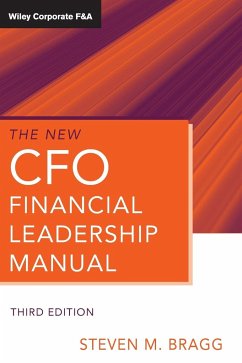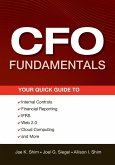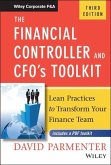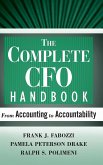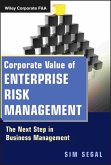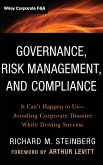Steven M. Bragg
The New CFO Financial Leadership Manual
Schade – dieser Artikel ist leider ausverkauft. Sobald wir wissen, ob und wann der Artikel wieder verfügbar ist, informieren wir Sie an dieser Stelle.
Steven M. Bragg
The New CFO Financial Leadership Manual
- Gebundenes Buch
- Merkliste
- Auf die Merkliste
- Bewerten Bewerten
- Teilen
- Produkt teilen
- Produkterinnerung
- Produkterinnerung
The comprehensive guide for CFOs who need an overview of leadership basics from strategies to management improvement tips Filled with pragmatic insights and proactive strategies, The New CFO Financial Leadership Manual, Third Edition is destined to become your essential desktop companion. This thorough guidebook is filled with best practices to help you, as CFO, to improve efficiency, mitigate risks, and keep your organization competitive.
Includes updated information on the relationship of the CFO with the Treasurer, registration statements and Fedwire payments, acquisitions integration,…mehr
Andere Kunden interessierten sich auch für
![CFO Fundamentals CFO Fundamentals]() Jae K. ShimCFO Fundamentals55,99 €
Jae K. ShimCFO Fundamentals55,99 €![CFO Survival Guide: Plotting the Course to Financial Leadership CFO Survival Guide: Plotting the Course to Financial Leadership]() StenzelCFO Survival Guide: Plotting the Course to Financial Leadership94,99 €
StenzelCFO Survival Guide: Plotting the Course to Financial Leadership94,99 €![The Financial Controller and Cfo's Toolkit The Financial Controller and Cfo's Toolkit]() David ParmenterThe Financial Controller and Cfo's Toolkit50,99 €
David ParmenterThe Financial Controller and Cfo's Toolkit50,99 €![The Complete CFO Handbook The Complete CFO Handbook]() Frank J. FabozziThe Complete CFO Handbook241,99 €
Frank J. FabozziThe Complete CFO Handbook241,99 €![Corporate Value of Enterprise Risk Management Corporate Value of Enterprise Risk Management]() Sim SegalCorporate Value of Enterprise Risk Management107,99 €
Sim SegalCorporate Value of Enterprise Risk Management107,99 €![Governance, Risk Management, and Compliance Governance, Risk Management, and Compliance]() Richard M. SteinbergGovernance, Risk Management, and Compliance46,99 €
Richard M. SteinbergGovernance, Risk Management, and Compliance46,99 €![Mergers, Acquisitions, and Corporate Restructurings Mergers, Acquisitions, and Corporate Restructurings]() Patrick A. GaughanMergers, Acquisitions, and Corporate Restructurings87,99 €
Patrick A. GaughanMergers, Acquisitions, and Corporate Restructurings87,99 €-
-
The comprehensive guide for CFOs who need an overview of leadership basics from strategies to management improvement tips
Filled with pragmatic insights and proactive strategies, The New CFO Financial Leadership Manual, Third Edition is destined to become your essential desktop companion. This thorough guidebook is filled with best practices to help you, as CFO, to improve efficiency, mitigate risks, and keep your organization competitive.
Includes updated information on the relationship of the CFO with the Treasurer, registration statements and Fedwire payments, acquisitions integration, legal types of acquisitions, and government regulations
Contains control flowcharts for the main accounting cycles
Provides new chapters on Investor Relations and Risk Management for Foreign Exchange and Interest Rates
Features an itemized list of the key tasks every new CFO should complete when first entering the position, a checklist of 100 performance measures, and a detailed discussion of employee compensation plans
The reference CFOs and other financial managers can turn to for quick answers to questions they have as well as to help them plan their financial strategy, The New CFO Financial Leadership Manual, Third Edition is mandatory reading for every CFO wanting to play a strategic role in their organization.
Filled with pragmatic insights and proactive strategies, The New CFO Financial Leadership Manual, Third Edition is destined to become your essential desktop companion. This thorough guidebook is filled with best practices to help you, as CFO, to improve efficiency, mitigate risks, and keep your organization competitive.
Includes updated information on the relationship of the CFO with the Treasurer, registration statements and Fedwire payments, acquisitions integration, legal types of acquisitions, and government regulations
Contains control flowcharts for the main accounting cycles
Provides new chapters on Investor Relations and Risk Management for Foreign Exchange and Interest Rates
Features an itemized list of the key tasks every new CFO should complete when first entering the position, a checklist of 100 performance measures, and a detailed discussion of employee compensation plans
The reference CFOs and other financial managers can turn to for quick answers to questions they have as well as to help them plan their financial strategy, The New CFO Financial Leadership Manual, Third Edition is mandatory reading for every CFO wanting to play a strategic role in their organization.
Produktdetails
- Produktdetails
- Wiley Corporate F&A
- Verlag: Wiley & Sons
- 3. Aufl.
- Seitenzahl: 512
- Erscheinungstermin: 14. Dezember 2010
- Englisch
- Abmessung: 260mm x 183mm x 31mm
- Gewicht: 1032g
- ISBN-13: 9780470882566
- ISBN-10: 0470882565
- Artikelnr.: 30366977
- Herstellerkennzeichnung
- Libri GmbH
- Europaallee 1
- 36244 Bad Hersfeld
- gpsr@libri.de
- Wiley Corporate F&A
- Verlag: Wiley & Sons
- 3. Aufl.
- Seitenzahl: 512
- Erscheinungstermin: 14. Dezember 2010
- Englisch
- Abmessung: 260mm x 183mm x 31mm
- Gewicht: 1032g
- ISBN-13: 9780470882566
- ISBN-10: 0470882565
- Artikelnr.: 30366977
- Herstellerkennzeichnung
- Libri GmbH
- Europaallee 1
- 36244 Bad Hersfeld
- gpsr@libri.de
STEVEN M. BRAGG, CPA, has been the chief financial officer or controller of four companies, as well as a consulting manager at Ernst & Young and auditor at Deloitte. He is the author of over forty books primarily targeted toward controllers and their needs. He received a master's degree in finance from Bentley College, an MBA from Babson College, and a bachelor's degree in economics from the University of Maine. He is also the author of Accounting Best Practices and Wiley GAAP, both published by Wiley.
Preface xiii
Part One: Overview
Chapter 1: CFO's Place in the Corporation 3
First Days in the Position 3
Specific CFO Responsibilities 4
Overview of the Change Management Process 8
Differences between the Controller and CFO Positions 9
Relationship of the Controller to the CFO 12
Other Direct Reports: The Treasurer 13
Other Direct Reports: The Investor Relations Officer 13
Summary 14
Chapter 2: Financial Strategy 15
Cash 15
Investments 17
Working Capital 19
Inventory: Inventory Reduction Decision 21
Fixed Assets: Lease versus Buy Decisions 23
Payables 23
Debt 26
Equity 28
Products: Product Elimination Decisions 32
Fixed Expenses: Step Costing Decisions 35
Payroll Expenses: Temporary Labor versus Permanent Staffing Decisions 36
Entities: Divestiture Decisions 38
Systems: When to Use Throughput Costing 39
High-Volume, Low-Price Sale Decisions Using Throughput Costing 43
Capital Budgeting Decisions Using Throughput Costing 44
Make versus Buy Decisions Using Throughput Costing 46
Summary 47
Chapter 3: Tax Strategy 48
Accumulated Earnings Tax 49
Cash Method of Accounting 50
Inventory Valuation 51
Mergers and Acquisitions 51
Net Operating Loss Carryforwards 52
Nexus 53
Project Costing 54
S Corporation 55
Sales and Use Taxes 56
Transfer Pricing 57
Unemployment Taxes 59
Summary 60
Chapter 4: Information Technology Strategy 61
Reasons for Devising an Information Technology Strategy 61
Developing the Information Technology Strategy 62
Technical Strategies 65
Specific Applications 67
Summary 70
Part Two: Accounting
Chapter 5: Performance Measurement Systems 73
Creating a Performance Measurement System 73
Asset Utilization Measurements 74
Operating Performance Measurements 79
Cash Flow Measurements 82
Liquidity Measurements 85
Solvency Measurements 90
Return on Investment Measurements 91
Market Performance Measurements 97
Summary 99
Chapter 6: Control Systems 100
Need for Control Systems 100
Types of Fraud 101
Key Controls 103
When to Eliminate Controls 118
Summary 119
Chapter 7: Audit Function 121
Composition of the Audit Committee 121
Role of the Audit Committee 122
Purpose of the External Auditors 124
Dealing with External Auditors 125
Impact of the Sarbanes-Oxley Act on the Audit Function 126
Role of the Internal Audit Function 128
Managing the Internal Audit Function 131
Summary 133
Part Three: Financial Analysis
Chapter 8: Cost of Capital 137
Components 137
Calculating the Cost of Debt 138
Calculating the Cost of Equity 140
Calculating the Weighted Cost of Capital 142
Incremental Cost of Capital 144
Using the Cost of Capital in Special Situations 146
Modifying the Cost of Capital to Enhance Shareholder Value 148
Strategizing Cost of Capital Reductions 151
Summary 152
Chapter 9: Capital Budgeting 153
Hurdle Rate 153
Payback Period 154
Net Present Value 156
Internal Rate of Return 158
Throughput-Based Capital Budgeting 161
Problems with the Capital Budget Approval Process 162
Cash Flow Modeling Issues 164
Funding Decisions for Research and Development Projects 165
Capital Investment Proposal Form 167
Post-Completion Project Analysis 170
Summary 172
Chapter 10: Other Financial Analysis Topics 173
Risk Analysis 173
Capacity Utilization 177
Breakeven Analysis 183
Business Cycle Forecasting 188
Summary 194
Part Four: Funding
Chapter 11: Cash Management and Consolidation 197
Cash Forecasting Model 197
Information Sources for the Cash Forecast 201
Measuring Cash Forecast Accuracy 201
Cash Forecasting Automation 202
Cash Concentration Overview 204
Physical Sweeping 204
Notional Pooling 206
Comparison of Account Sweeping and Notional Pooling 207
Cash Management Controls 208
Summary 212
Chapter 12: Investing Excess Funds 213
Investment Criteria 213
Investment Restrictions 214
Investment Options 214
Investment Strategies 216
Summary 219
Chapter 13: Obtaining Debt Financing 220
Management of Financing Issues 220
Bank Relations 221
Accounts Payable Payment Delay 222
Accounts Receivable Collection Acceleration 223
Credit Cards 224
Employee Trade-Offs 224
Factoring 224
Field Warehouse Financing 225
Floor Planning 226
Inventory Reduction 226
Lease 227
Line of Credit 228
Loans 228
Merchant Card Advances 234
Preferred Stock 234
Sale and Leaseback 235
Summary 235
Chapter 14: Obtaining Equity Financing 238
Types of Stock 238
Private Placement of Stock 239
Layout of the Offering Memorandum 240
Establishing a Valuation for the Offering Memorandum 252
Swapping Stock for Expenses 253
Swapping Stock for Cash 254
Stock Warrants 254
Stock Subscriptions 255
Private Investment in Public Equity 255
Buying Back Shares 256
Rule 144 257
Rule 10b5-1 258
Summary 261
Part Five: Publicly Held Company
Chapter 15: Initial Public Offering 265
Reasons to Go Public 265
Reasons Not to Go Public 266
Cost of an IPO 268
Preparing for the IPO 269
Finding an Underwriter 271
Registering for and Completing the IPO 274
Alternatives for Selling Securities 277
Trading on an Exchange 279
American Stock Exchange 280
Overview of the NASDAQ 282
New York Stock Exchange 283
Comparing the Stock Exchanges 285
Over-the-Counter Stocks 287
Summary 287
Chapter 16: Reports to the Securities and Exchange Commission 288
Overview 288
Form 8-K 289
Form 10-Q and Form 10-K 294
Form S-1 297
Form S-3 299
Form S-8 300
Shelf Registration 300
Declaring a Registration Statement Effective 301
Reporting Insider Securities Ownership and Trading 302
EDGAR Filing System 306
Fedwire Payments 308
Summary 310
Chapter 17: Investment Community 311
Introduction 311
Analyst's Perspective 311
Finding the Right Analyst 313
Sell Side: Analysts 314
Negative Analyst Report 316
Sell Side: Brokers 316
Sell Side: Investment Bankers 318
Sell Side: Investor Relations Specialists 318
Buy Side: Types of Investors 319
Buy Side: Institutional Investors 319
Buy Side: Individual Investors 321
Buy Side: Presentations to Investors 323
Summary 323
Chapter 18: Taking a Company Private 325
Going Private Transaction 325
Rule 13e-3 325
Filling Out Schedule 13E-3 326
300-Shareholder Limit 329
Form 15 330
Summary 330
Part Six: Management
Chapter 19: Risk Management-General Concepts 333
Risk Management Policies 334
Risk Management Planning 335
Manager of Risk Management 337
Risk Management Procedures 338
Types of Insurance Companies 341
Evaluating the Health of an Insurance Carrier 343
Claims Administration 344
Insurance Files 345
Annual Risk Management Report 346
Summary 347
Chapter 20: Risk Management: Foreign Exchange 348
Foreign Exchange Quote Terminology 348
Nature of Foreign Exchange Risk 349
Data Collection for Foreign Exchange Risk Management 350
Foreign Exchange Hedging Strategies 351
Accept the Risk 352
Insist on Home Currency Payment 352
Currency Surcharges 353
Get Paid on Time 353
Foreign Currency Loans 353
Sourcing Changes 353
Foreign Currency Accounts 354
Unilateral, Bilateral, and Multilateral Netting Arrangements 354
Forward Exchange Contracts 355
Currency Futures 357
Currency Options 358
Currency Swaps 360
Proxy Hedging 362
Summary 362
Chapter 21: Outsourcing the Accounting and Finance Functions 363
Advantages and Disadvantages of Outsourcing 363
Contractual Issues 368
Transition Issues 370
Controlling Supplier Performance 372
Measuring Outsourced Activities 373
Managing Suppliers 379
Dropping Suppliers 379
Summary 381
Chapter 22: Mergers and Acquisitions 382
Evaluating Acquisition Targets 382
Complexity Analysis 400
Evaluate Acquisition Targets with Alliances 401
Valuing an Acquisition Target 402
Alternative Valuation Methods 402
Control Premium 406
Synergy Gains 406
Discounted Cash Flow (DCF) Model 407
Constructing Cash Flow Scenarios 409
Cash Flow Adjusting Factors 410
Earnout 412
Qualitative Factors 413
Which Valuation Method Is Best? 414
Method of Payment 415
Types of Acquisitions 416
Tax Implications of an Acquisition 416
Asset Acquisition 418
Type ''A'' Reorganization 419
Type ''B'' Reorganization 420
Type ''C'' Reorganization 421
Type ''D'' Reorganization 422
Triangular Merger 423
Reverse Triangular Merger 423
Terms of the Acquisition Agreement 424
When to Use an Investment Banker 424
Summary 425
Part Seven: Other Topics
Chapter 23: Employee Compensation 429
Deferred Compensation 429
Life Insurance 431
Stock Appreciation Rights 432
Stock Options 432
Restricted Stock Units 435
Bonus Sliding Scale 435
Cut Benefit Costs with a Captive Insurance Company 436
Summary 436
Chapter 24: BANKRUPTCY 437
Applicable Bankruptcy Laws 437
Players in the Bankruptcy Drama 438
Creditor and Shareholder Payment Priorities 439
Bankruptcy Sequence of Events 440
Tax Liabilities in a Bankruptcy 446
Special Bankruptcy Rules 447
Bankruptcy Act of 2005 448
Alternatives to Bankruptcy 448
Summary 449
Appendix A: New CFO Checklist 451
Appendix B: Performance Measurement Checklist 456
Appendix C: Due Diligence Checklist 465
About the Author 474
Index 477
Part One: Overview
Chapter 1: CFO's Place in the Corporation 3
First Days in the Position 3
Specific CFO Responsibilities 4
Overview of the Change Management Process 8
Differences between the Controller and CFO Positions 9
Relationship of the Controller to the CFO 12
Other Direct Reports: The Treasurer 13
Other Direct Reports: The Investor Relations Officer 13
Summary 14
Chapter 2: Financial Strategy 15
Cash 15
Investments 17
Working Capital 19
Inventory: Inventory Reduction Decision 21
Fixed Assets: Lease versus Buy Decisions 23
Payables 23
Debt 26
Equity 28
Products: Product Elimination Decisions 32
Fixed Expenses: Step Costing Decisions 35
Payroll Expenses: Temporary Labor versus Permanent Staffing Decisions 36
Entities: Divestiture Decisions 38
Systems: When to Use Throughput Costing 39
High-Volume, Low-Price Sale Decisions Using Throughput Costing 43
Capital Budgeting Decisions Using Throughput Costing 44
Make versus Buy Decisions Using Throughput Costing 46
Summary 47
Chapter 3: Tax Strategy 48
Accumulated Earnings Tax 49
Cash Method of Accounting 50
Inventory Valuation 51
Mergers and Acquisitions 51
Net Operating Loss Carryforwards 52
Nexus 53
Project Costing 54
S Corporation 55
Sales and Use Taxes 56
Transfer Pricing 57
Unemployment Taxes 59
Summary 60
Chapter 4: Information Technology Strategy 61
Reasons for Devising an Information Technology Strategy 61
Developing the Information Technology Strategy 62
Technical Strategies 65
Specific Applications 67
Summary 70
Part Two: Accounting
Chapter 5: Performance Measurement Systems 73
Creating a Performance Measurement System 73
Asset Utilization Measurements 74
Operating Performance Measurements 79
Cash Flow Measurements 82
Liquidity Measurements 85
Solvency Measurements 90
Return on Investment Measurements 91
Market Performance Measurements 97
Summary 99
Chapter 6: Control Systems 100
Need for Control Systems 100
Types of Fraud 101
Key Controls 103
When to Eliminate Controls 118
Summary 119
Chapter 7: Audit Function 121
Composition of the Audit Committee 121
Role of the Audit Committee 122
Purpose of the External Auditors 124
Dealing with External Auditors 125
Impact of the Sarbanes-Oxley Act on the Audit Function 126
Role of the Internal Audit Function 128
Managing the Internal Audit Function 131
Summary 133
Part Three: Financial Analysis
Chapter 8: Cost of Capital 137
Components 137
Calculating the Cost of Debt 138
Calculating the Cost of Equity 140
Calculating the Weighted Cost of Capital 142
Incremental Cost of Capital 144
Using the Cost of Capital in Special Situations 146
Modifying the Cost of Capital to Enhance Shareholder Value 148
Strategizing Cost of Capital Reductions 151
Summary 152
Chapter 9: Capital Budgeting 153
Hurdle Rate 153
Payback Period 154
Net Present Value 156
Internal Rate of Return 158
Throughput-Based Capital Budgeting 161
Problems with the Capital Budget Approval Process 162
Cash Flow Modeling Issues 164
Funding Decisions for Research and Development Projects 165
Capital Investment Proposal Form 167
Post-Completion Project Analysis 170
Summary 172
Chapter 10: Other Financial Analysis Topics 173
Risk Analysis 173
Capacity Utilization 177
Breakeven Analysis 183
Business Cycle Forecasting 188
Summary 194
Part Four: Funding
Chapter 11: Cash Management and Consolidation 197
Cash Forecasting Model 197
Information Sources for the Cash Forecast 201
Measuring Cash Forecast Accuracy 201
Cash Forecasting Automation 202
Cash Concentration Overview 204
Physical Sweeping 204
Notional Pooling 206
Comparison of Account Sweeping and Notional Pooling 207
Cash Management Controls 208
Summary 212
Chapter 12: Investing Excess Funds 213
Investment Criteria 213
Investment Restrictions 214
Investment Options 214
Investment Strategies 216
Summary 219
Chapter 13: Obtaining Debt Financing 220
Management of Financing Issues 220
Bank Relations 221
Accounts Payable Payment Delay 222
Accounts Receivable Collection Acceleration 223
Credit Cards 224
Employee Trade-Offs 224
Factoring 224
Field Warehouse Financing 225
Floor Planning 226
Inventory Reduction 226
Lease 227
Line of Credit 228
Loans 228
Merchant Card Advances 234
Preferred Stock 234
Sale and Leaseback 235
Summary 235
Chapter 14: Obtaining Equity Financing 238
Types of Stock 238
Private Placement of Stock 239
Layout of the Offering Memorandum 240
Establishing a Valuation for the Offering Memorandum 252
Swapping Stock for Expenses 253
Swapping Stock for Cash 254
Stock Warrants 254
Stock Subscriptions 255
Private Investment in Public Equity 255
Buying Back Shares 256
Rule 144 257
Rule 10b5-1 258
Summary 261
Part Five: Publicly Held Company
Chapter 15: Initial Public Offering 265
Reasons to Go Public 265
Reasons Not to Go Public 266
Cost of an IPO 268
Preparing for the IPO 269
Finding an Underwriter 271
Registering for and Completing the IPO 274
Alternatives for Selling Securities 277
Trading on an Exchange 279
American Stock Exchange 280
Overview of the NASDAQ 282
New York Stock Exchange 283
Comparing the Stock Exchanges 285
Over-the-Counter Stocks 287
Summary 287
Chapter 16: Reports to the Securities and Exchange Commission 288
Overview 288
Form 8-K 289
Form 10-Q and Form 10-K 294
Form S-1 297
Form S-3 299
Form S-8 300
Shelf Registration 300
Declaring a Registration Statement Effective 301
Reporting Insider Securities Ownership and Trading 302
EDGAR Filing System 306
Fedwire Payments 308
Summary 310
Chapter 17: Investment Community 311
Introduction 311
Analyst's Perspective 311
Finding the Right Analyst 313
Sell Side: Analysts 314
Negative Analyst Report 316
Sell Side: Brokers 316
Sell Side: Investment Bankers 318
Sell Side: Investor Relations Specialists 318
Buy Side: Types of Investors 319
Buy Side: Institutional Investors 319
Buy Side: Individual Investors 321
Buy Side: Presentations to Investors 323
Summary 323
Chapter 18: Taking a Company Private 325
Going Private Transaction 325
Rule 13e-3 325
Filling Out Schedule 13E-3 326
300-Shareholder Limit 329
Form 15 330
Summary 330
Part Six: Management
Chapter 19: Risk Management-General Concepts 333
Risk Management Policies 334
Risk Management Planning 335
Manager of Risk Management 337
Risk Management Procedures 338
Types of Insurance Companies 341
Evaluating the Health of an Insurance Carrier 343
Claims Administration 344
Insurance Files 345
Annual Risk Management Report 346
Summary 347
Chapter 20: Risk Management: Foreign Exchange 348
Foreign Exchange Quote Terminology 348
Nature of Foreign Exchange Risk 349
Data Collection for Foreign Exchange Risk Management 350
Foreign Exchange Hedging Strategies 351
Accept the Risk 352
Insist on Home Currency Payment 352
Currency Surcharges 353
Get Paid on Time 353
Foreign Currency Loans 353
Sourcing Changes 353
Foreign Currency Accounts 354
Unilateral, Bilateral, and Multilateral Netting Arrangements 354
Forward Exchange Contracts 355
Currency Futures 357
Currency Options 358
Currency Swaps 360
Proxy Hedging 362
Summary 362
Chapter 21: Outsourcing the Accounting and Finance Functions 363
Advantages and Disadvantages of Outsourcing 363
Contractual Issues 368
Transition Issues 370
Controlling Supplier Performance 372
Measuring Outsourced Activities 373
Managing Suppliers 379
Dropping Suppliers 379
Summary 381
Chapter 22: Mergers and Acquisitions 382
Evaluating Acquisition Targets 382
Complexity Analysis 400
Evaluate Acquisition Targets with Alliances 401
Valuing an Acquisition Target 402
Alternative Valuation Methods 402
Control Premium 406
Synergy Gains 406
Discounted Cash Flow (DCF) Model 407
Constructing Cash Flow Scenarios 409
Cash Flow Adjusting Factors 410
Earnout 412
Qualitative Factors 413
Which Valuation Method Is Best? 414
Method of Payment 415
Types of Acquisitions 416
Tax Implications of an Acquisition 416
Asset Acquisition 418
Type ''A'' Reorganization 419
Type ''B'' Reorganization 420
Type ''C'' Reorganization 421
Type ''D'' Reorganization 422
Triangular Merger 423
Reverse Triangular Merger 423
Terms of the Acquisition Agreement 424
When to Use an Investment Banker 424
Summary 425
Part Seven: Other Topics
Chapter 23: Employee Compensation 429
Deferred Compensation 429
Life Insurance 431
Stock Appreciation Rights 432
Stock Options 432
Restricted Stock Units 435
Bonus Sliding Scale 435
Cut Benefit Costs with a Captive Insurance Company 436
Summary 436
Chapter 24: BANKRUPTCY 437
Applicable Bankruptcy Laws 437
Players in the Bankruptcy Drama 438
Creditor and Shareholder Payment Priorities 439
Bankruptcy Sequence of Events 440
Tax Liabilities in a Bankruptcy 446
Special Bankruptcy Rules 447
Bankruptcy Act of 2005 448
Alternatives to Bankruptcy 448
Summary 449
Appendix A: New CFO Checklist 451
Appendix B: Performance Measurement Checklist 456
Appendix C: Due Diligence Checklist 465
About the Author 474
Index 477
Preface xiii
Part One: Overview
Chapter 1: CFO's Place in the Corporation 3
First Days in the Position 3
Specific CFO Responsibilities 4
Overview of the Change Management Process 8
Differences between the Controller and CFO Positions 9
Relationship of the Controller to the CFO 12
Other Direct Reports: The Treasurer 13
Other Direct Reports: The Investor Relations Officer 13
Summary 14
Chapter 2: Financial Strategy 15
Cash 15
Investments 17
Working Capital 19
Inventory: Inventory Reduction Decision 21
Fixed Assets: Lease versus Buy Decisions 23
Payables 23
Debt 26
Equity 28
Products: Product Elimination Decisions 32
Fixed Expenses: Step Costing Decisions 35
Payroll Expenses: Temporary Labor versus Permanent Staffing Decisions 36
Entities: Divestiture Decisions 38
Systems: When to Use Throughput Costing 39
High-Volume, Low-Price Sale Decisions Using Throughput Costing 43
Capital Budgeting Decisions Using Throughput Costing 44
Make versus Buy Decisions Using Throughput Costing 46
Summary 47
Chapter 3: Tax Strategy 48
Accumulated Earnings Tax 49
Cash Method of Accounting 50
Inventory Valuation 51
Mergers and Acquisitions 51
Net Operating Loss Carryforwards 52
Nexus 53
Project Costing 54
S Corporation 55
Sales and Use Taxes 56
Transfer Pricing 57
Unemployment Taxes 59
Summary 60
Chapter 4: Information Technology Strategy 61
Reasons for Devising an Information Technology Strategy 61
Developing the Information Technology Strategy 62
Technical Strategies 65
Specific Applications 67
Summary 70
Part Two: Accounting
Chapter 5: Performance Measurement Systems 73
Creating a Performance Measurement System 73
Asset Utilization Measurements 74
Operating Performance Measurements 79
Cash Flow Measurements 82
Liquidity Measurements 85
Solvency Measurements 90
Return on Investment Measurements 91
Market Performance Measurements 97
Summary 99
Chapter 6: Control Systems 100
Need for Control Systems 100
Types of Fraud 101
Key Controls 103
When to Eliminate Controls 118
Summary 119
Chapter 7: Audit Function 121
Composition of the Audit Committee 121
Role of the Audit Committee 122
Purpose of the External Auditors 124
Dealing with External Auditors 125
Impact of the Sarbanes-Oxley Act on the Audit Function 126
Role of the Internal Audit Function 128
Managing the Internal Audit Function 131
Summary 133
Part Three: Financial Analysis
Chapter 8: Cost of Capital 137
Components 137
Calculating the Cost of Debt 138
Calculating the Cost of Equity 140
Calculating the Weighted Cost of Capital 142
Incremental Cost of Capital 144
Using the Cost of Capital in Special Situations 146
Modifying the Cost of Capital to Enhance Shareholder Value 148
Strategizing Cost of Capital Reductions 151
Summary 152
Chapter 9: Capital Budgeting 153
Hurdle Rate 153
Payback Period 154
Net Present Value 156
Internal Rate of Return 158
Throughput-Based Capital Budgeting 161
Problems with the Capital Budget Approval Process 162
Cash Flow Modeling Issues 164
Funding Decisions for Research and Development Projects 165
Capital Investment Proposal Form 167
Post-Completion Project Analysis 170
Summary 172
Chapter 10: Other Financial Analysis Topics 173
Risk Analysis 173
Capacity Utilization 177
Breakeven Analysis 183
Business Cycle Forecasting 188
Summary 194
Part Four: Funding
Chapter 11: Cash Management and Consolidation 197
Cash Forecasting Model 197
Information Sources for the Cash Forecast 201
Measuring Cash Forecast Accuracy 201
Cash Forecasting Automation 202
Cash Concentration Overview 204
Physical Sweeping 204
Notional Pooling 206
Comparison of Account Sweeping and Notional Pooling 207
Cash Management Controls 208
Summary 212
Chapter 12: Investing Excess Funds 213
Investment Criteria 213
Investment Restrictions 214
Investment Options 214
Investment Strategies 216
Summary 219
Chapter 13: Obtaining Debt Financing 220
Management of Financing Issues 220
Bank Relations 221
Accounts Payable Payment Delay 222
Accounts Receivable Collection Acceleration 223
Credit Cards 224
Employee Trade-Offs 224
Factoring 224
Field Warehouse Financing 225
Floor Planning 226
Inventory Reduction 226
Lease 227
Line of Credit 228
Loans 228
Merchant Card Advances 234
Preferred Stock 234
Sale and Leaseback 235
Summary 235
Chapter 14: Obtaining Equity Financing 238
Types of Stock 238
Private Placement of Stock 239
Layout of the Offering Memorandum 240
Establishing a Valuation for the Offering Memorandum 252
Swapping Stock for Expenses 253
Swapping Stock for Cash 254
Stock Warrants 254
Stock Subscriptions 255
Private Investment in Public Equity 255
Buying Back Shares 256
Rule 144 257
Rule 10b5-1 258
Summary 261
Part Five: Publicly Held Company
Chapter 15: Initial Public Offering 265
Reasons to Go Public 265
Reasons Not to Go Public 266
Cost of an IPO 268
Preparing for the IPO 269
Finding an Underwriter 271
Registering for and Completing the IPO 274
Alternatives for Selling Securities 277
Trading on an Exchange 279
American Stock Exchange 280
Overview of the NASDAQ 282
New York Stock Exchange 283
Comparing the Stock Exchanges 285
Over-the-Counter Stocks 287
Summary 287
Chapter 16: Reports to the Securities and Exchange Commission 288
Overview 288
Form 8-K 289
Form 10-Q and Form 10-K 294
Form S-1 297
Form S-3 299
Form S-8 300
Shelf Registration 300
Declaring a Registration Statement Effective 301
Reporting Insider Securities Ownership and Trading 302
EDGAR Filing System 306
Fedwire Payments 308
Summary 310
Chapter 17: Investment Community 311
Introduction 311
Analyst's Perspective 311
Finding the Right Analyst 313
Sell Side: Analysts 314
Negative Analyst Report 316
Sell Side: Brokers 316
Sell Side: Investment Bankers 318
Sell Side: Investor Relations Specialists 318
Buy Side: Types of Investors 319
Buy Side: Institutional Investors 319
Buy Side: Individual Investors 321
Buy Side: Presentations to Investors 323
Summary 323
Chapter 18: Taking a Company Private 325
Going Private Transaction 325
Rule 13e-3 325
Filling Out Schedule 13E-3 326
300-Shareholder Limit 329
Form 15 330
Summary 330
Part Six: Management
Chapter 19: Risk Management-General Concepts 333
Risk Management Policies 334
Risk Management Planning 335
Manager of Risk Management 337
Risk Management Procedures 338
Types of Insurance Companies 341
Evaluating the Health of an Insurance Carrier 343
Claims Administration 344
Insurance Files 345
Annual Risk Management Report 346
Summary 347
Chapter 20: Risk Management: Foreign Exchange 348
Foreign Exchange Quote Terminology 348
Nature of Foreign Exchange Risk 349
Data Collection for Foreign Exchange Risk Management 350
Foreign Exchange Hedging Strategies 351
Accept the Risk 352
Insist on Home Currency Payment 352
Currency Surcharges 353
Get Paid on Time 353
Foreign Currency Loans 353
Sourcing Changes 353
Foreign Currency Accounts 354
Unilateral, Bilateral, and Multilateral Netting Arrangements 354
Forward Exchange Contracts 355
Currency Futures 357
Currency Options 358
Currency Swaps 360
Proxy Hedging 362
Summary 362
Chapter 21: Outsourcing the Accounting and Finance Functions 363
Advantages and Disadvantages of Outsourcing 363
Contractual Issues 368
Transition Issues 370
Controlling Supplier Performance 372
Measuring Outsourced Activities 373
Managing Suppliers 379
Dropping Suppliers 379
Summary 381
Chapter 22: Mergers and Acquisitions 382
Evaluating Acquisition Targets 382
Complexity Analysis 400
Evaluate Acquisition Targets with Alliances 401
Valuing an Acquisition Target 402
Alternative Valuation Methods 402
Control Premium 406
Synergy Gains 406
Discounted Cash Flow (DCF) Model 407
Constructing Cash Flow Scenarios 409
Cash Flow Adjusting Factors 410
Earnout 412
Qualitative Factors 413
Which Valuation Method Is Best? 414
Method of Payment 415
Types of Acquisitions 416
Tax Implications of an Acquisition 416
Asset Acquisition 418
Type ''A'' Reorganization 419
Type ''B'' Reorganization 420
Type ''C'' Reorganization 421
Type ''D'' Reorganization 422
Triangular Merger 423
Reverse Triangular Merger 423
Terms of the Acquisition Agreement 424
When to Use an Investment Banker 424
Summary 425
Part Seven: Other Topics
Chapter 23: Employee Compensation 429
Deferred Compensation 429
Life Insurance 431
Stock Appreciation Rights 432
Stock Options 432
Restricted Stock Units 435
Bonus Sliding Scale 435
Cut Benefit Costs with a Captive Insurance Company 436
Summary 436
Chapter 24: BANKRUPTCY 437
Applicable Bankruptcy Laws 437
Players in the Bankruptcy Drama 438
Creditor and Shareholder Payment Priorities 439
Bankruptcy Sequence of Events 440
Tax Liabilities in a Bankruptcy 446
Special Bankruptcy Rules 447
Bankruptcy Act of 2005 448
Alternatives to Bankruptcy 448
Summary 449
Appendix A: New CFO Checklist 451
Appendix B: Performance Measurement Checklist 456
Appendix C: Due Diligence Checklist 465
About the Author 474
Index 477
Part One: Overview
Chapter 1: CFO's Place in the Corporation 3
First Days in the Position 3
Specific CFO Responsibilities 4
Overview of the Change Management Process 8
Differences between the Controller and CFO Positions 9
Relationship of the Controller to the CFO 12
Other Direct Reports: The Treasurer 13
Other Direct Reports: The Investor Relations Officer 13
Summary 14
Chapter 2: Financial Strategy 15
Cash 15
Investments 17
Working Capital 19
Inventory: Inventory Reduction Decision 21
Fixed Assets: Lease versus Buy Decisions 23
Payables 23
Debt 26
Equity 28
Products: Product Elimination Decisions 32
Fixed Expenses: Step Costing Decisions 35
Payroll Expenses: Temporary Labor versus Permanent Staffing Decisions 36
Entities: Divestiture Decisions 38
Systems: When to Use Throughput Costing 39
High-Volume, Low-Price Sale Decisions Using Throughput Costing 43
Capital Budgeting Decisions Using Throughput Costing 44
Make versus Buy Decisions Using Throughput Costing 46
Summary 47
Chapter 3: Tax Strategy 48
Accumulated Earnings Tax 49
Cash Method of Accounting 50
Inventory Valuation 51
Mergers and Acquisitions 51
Net Operating Loss Carryforwards 52
Nexus 53
Project Costing 54
S Corporation 55
Sales and Use Taxes 56
Transfer Pricing 57
Unemployment Taxes 59
Summary 60
Chapter 4: Information Technology Strategy 61
Reasons for Devising an Information Technology Strategy 61
Developing the Information Technology Strategy 62
Technical Strategies 65
Specific Applications 67
Summary 70
Part Two: Accounting
Chapter 5: Performance Measurement Systems 73
Creating a Performance Measurement System 73
Asset Utilization Measurements 74
Operating Performance Measurements 79
Cash Flow Measurements 82
Liquidity Measurements 85
Solvency Measurements 90
Return on Investment Measurements 91
Market Performance Measurements 97
Summary 99
Chapter 6: Control Systems 100
Need for Control Systems 100
Types of Fraud 101
Key Controls 103
When to Eliminate Controls 118
Summary 119
Chapter 7: Audit Function 121
Composition of the Audit Committee 121
Role of the Audit Committee 122
Purpose of the External Auditors 124
Dealing with External Auditors 125
Impact of the Sarbanes-Oxley Act on the Audit Function 126
Role of the Internal Audit Function 128
Managing the Internal Audit Function 131
Summary 133
Part Three: Financial Analysis
Chapter 8: Cost of Capital 137
Components 137
Calculating the Cost of Debt 138
Calculating the Cost of Equity 140
Calculating the Weighted Cost of Capital 142
Incremental Cost of Capital 144
Using the Cost of Capital in Special Situations 146
Modifying the Cost of Capital to Enhance Shareholder Value 148
Strategizing Cost of Capital Reductions 151
Summary 152
Chapter 9: Capital Budgeting 153
Hurdle Rate 153
Payback Period 154
Net Present Value 156
Internal Rate of Return 158
Throughput-Based Capital Budgeting 161
Problems with the Capital Budget Approval Process 162
Cash Flow Modeling Issues 164
Funding Decisions for Research and Development Projects 165
Capital Investment Proposal Form 167
Post-Completion Project Analysis 170
Summary 172
Chapter 10: Other Financial Analysis Topics 173
Risk Analysis 173
Capacity Utilization 177
Breakeven Analysis 183
Business Cycle Forecasting 188
Summary 194
Part Four: Funding
Chapter 11: Cash Management and Consolidation 197
Cash Forecasting Model 197
Information Sources for the Cash Forecast 201
Measuring Cash Forecast Accuracy 201
Cash Forecasting Automation 202
Cash Concentration Overview 204
Physical Sweeping 204
Notional Pooling 206
Comparison of Account Sweeping and Notional Pooling 207
Cash Management Controls 208
Summary 212
Chapter 12: Investing Excess Funds 213
Investment Criteria 213
Investment Restrictions 214
Investment Options 214
Investment Strategies 216
Summary 219
Chapter 13: Obtaining Debt Financing 220
Management of Financing Issues 220
Bank Relations 221
Accounts Payable Payment Delay 222
Accounts Receivable Collection Acceleration 223
Credit Cards 224
Employee Trade-Offs 224
Factoring 224
Field Warehouse Financing 225
Floor Planning 226
Inventory Reduction 226
Lease 227
Line of Credit 228
Loans 228
Merchant Card Advances 234
Preferred Stock 234
Sale and Leaseback 235
Summary 235
Chapter 14: Obtaining Equity Financing 238
Types of Stock 238
Private Placement of Stock 239
Layout of the Offering Memorandum 240
Establishing a Valuation for the Offering Memorandum 252
Swapping Stock for Expenses 253
Swapping Stock for Cash 254
Stock Warrants 254
Stock Subscriptions 255
Private Investment in Public Equity 255
Buying Back Shares 256
Rule 144 257
Rule 10b5-1 258
Summary 261
Part Five: Publicly Held Company
Chapter 15: Initial Public Offering 265
Reasons to Go Public 265
Reasons Not to Go Public 266
Cost of an IPO 268
Preparing for the IPO 269
Finding an Underwriter 271
Registering for and Completing the IPO 274
Alternatives for Selling Securities 277
Trading on an Exchange 279
American Stock Exchange 280
Overview of the NASDAQ 282
New York Stock Exchange 283
Comparing the Stock Exchanges 285
Over-the-Counter Stocks 287
Summary 287
Chapter 16: Reports to the Securities and Exchange Commission 288
Overview 288
Form 8-K 289
Form 10-Q and Form 10-K 294
Form S-1 297
Form S-3 299
Form S-8 300
Shelf Registration 300
Declaring a Registration Statement Effective 301
Reporting Insider Securities Ownership and Trading 302
EDGAR Filing System 306
Fedwire Payments 308
Summary 310
Chapter 17: Investment Community 311
Introduction 311
Analyst's Perspective 311
Finding the Right Analyst 313
Sell Side: Analysts 314
Negative Analyst Report 316
Sell Side: Brokers 316
Sell Side: Investment Bankers 318
Sell Side: Investor Relations Specialists 318
Buy Side: Types of Investors 319
Buy Side: Institutional Investors 319
Buy Side: Individual Investors 321
Buy Side: Presentations to Investors 323
Summary 323
Chapter 18: Taking a Company Private 325
Going Private Transaction 325
Rule 13e-3 325
Filling Out Schedule 13E-3 326
300-Shareholder Limit 329
Form 15 330
Summary 330
Part Six: Management
Chapter 19: Risk Management-General Concepts 333
Risk Management Policies 334
Risk Management Planning 335
Manager of Risk Management 337
Risk Management Procedures 338
Types of Insurance Companies 341
Evaluating the Health of an Insurance Carrier 343
Claims Administration 344
Insurance Files 345
Annual Risk Management Report 346
Summary 347
Chapter 20: Risk Management: Foreign Exchange 348
Foreign Exchange Quote Terminology 348
Nature of Foreign Exchange Risk 349
Data Collection for Foreign Exchange Risk Management 350
Foreign Exchange Hedging Strategies 351
Accept the Risk 352
Insist on Home Currency Payment 352
Currency Surcharges 353
Get Paid on Time 353
Foreign Currency Loans 353
Sourcing Changes 353
Foreign Currency Accounts 354
Unilateral, Bilateral, and Multilateral Netting Arrangements 354
Forward Exchange Contracts 355
Currency Futures 357
Currency Options 358
Currency Swaps 360
Proxy Hedging 362
Summary 362
Chapter 21: Outsourcing the Accounting and Finance Functions 363
Advantages and Disadvantages of Outsourcing 363
Contractual Issues 368
Transition Issues 370
Controlling Supplier Performance 372
Measuring Outsourced Activities 373
Managing Suppliers 379
Dropping Suppliers 379
Summary 381
Chapter 22: Mergers and Acquisitions 382
Evaluating Acquisition Targets 382
Complexity Analysis 400
Evaluate Acquisition Targets with Alliances 401
Valuing an Acquisition Target 402
Alternative Valuation Methods 402
Control Premium 406
Synergy Gains 406
Discounted Cash Flow (DCF) Model 407
Constructing Cash Flow Scenarios 409
Cash Flow Adjusting Factors 410
Earnout 412
Qualitative Factors 413
Which Valuation Method Is Best? 414
Method of Payment 415
Types of Acquisitions 416
Tax Implications of an Acquisition 416
Asset Acquisition 418
Type ''A'' Reorganization 419
Type ''B'' Reorganization 420
Type ''C'' Reorganization 421
Type ''D'' Reorganization 422
Triangular Merger 423
Reverse Triangular Merger 423
Terms of the Acquisition Agreement 424
When to Use an Investment Banker 424
Summary 425
Part Seven: Other Topics
Chapter 23: Employee Compensation 429
Deferred Compensation 429
Life Insurance 431
Stock Appreciation Rights 432
Stock Options 432
Restricted Stock Units 435
Bonus Sliding Scale 435
Cut Benefit Costs with a Captive Insurance Company 436
Summary 436
Chapter 24: BANKRUPTCY 437
Applicable Bankruptcy Laws 437
Players in the Bankruptcy Drama 438
Creditor and Shareholder Payment Priorities 439
Bankruptcy Sequence of Events 440
Tax Liabilities in a Bankruptcy 446
Special Bankruptcy Rules 447
Bankruptcy Act of 2005 448
Alternatives to Bankruptcy 448
Summary 449
Appendix A: New CFO Checklist 451
Appendix B: Performance Measurement Checklist 456
Appendix C: Due Diligence Checklist 465
About the Author 474
Index 477

